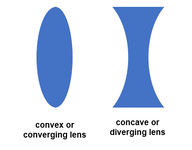
Lenses are an important application of refraction with their ability to produce both virtual and real images.
As a result they are used to magnify, focus light, project images for cinema, not to mention that your sight depends on your lenses to focus light on to your retina.
Lenses generally can be described as either convex, or concave (though there are variations)
As a result they are used to magnify, focus light, project images for cinema, not to mention that your sight depends on your lenses to focus light on to your retina.
Lenses generally can be described as either convex, or concave (though there are variations)
|
Interactive
Lets start by playing with this interactive
(The video at the right shows how you can use the interactive) When you are ready to move on we will explore virtual and real images. |
|
Virtual ImagesVirtual images are ones that CANNOT be projected on to a screen. Both convex and concave lenses can form virtual images.
A good example is the enlarged view of the ant you see in a magnifying glass. What you see appears on the other side of the lens but it cannot be projected. This video explains the reason why. |
|
|
|
Real image formationReal images are ones that CAN be projected on to a screen. Only convex lenses can form real images.
The video explains why |
Interactive
This interactive from pHET allows you to move your object and see where the image is formed.
This interactive from pHET allows you to move your object and see where the image is formed.
- Choose LENS
- Move the object (a pencil though you can change this). As long as it stay beyond the focus, the yellow dot, it will produce a real image on the other side
It may be larger or smaller then the object, depending on the object position in relation to the focus, but it will always be inverted - Move the pencil in front of the focus. You will now get an enlarge virtual image on the same side that is not inverted
- Altering the curvature will alter the magnification/reduction of the image (maths to be discussed in a future video)
- Change the lens to a concave lens and confirm that only virtual images are possible
The physics of the eyeA good example and application of real image formation is your eyesight.
Your eye uses the concept of real image formation to project an image on your retina and the adjusts the amount of refraction through a process called accomodation. This video explores this, and includes a discussion on corrective lenses |
|
Interactive
This interactive allows to manipulate an 'object' and place it correctly so the image forms on the retina (from Tom Walsh)
This interactive allows to manipulate an 'object' and place it correctly so the image forms on the retina (from Tom Walsh)
